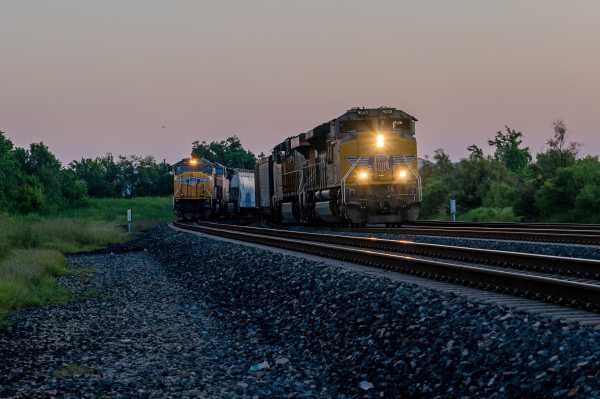
Editor’s note, September 15, 9 am: Railroads and union leaders announced early Thursday morning that they had reached a tentative deal to avert a strike, which now goes to the unions’ membership for a vote. Workers will not go on strike while voting is underway. The original story, which was published September 14, before the deal was announced, is below.
A railroad strike that would disrupt the entire American economy: not ideal, given, you know, everything. Yet one could be on the horizon.
Tens of thousands of freight rail workers are prepared to go on strike on Friday at 12:01 am, which could have wide-ranging effects across the economy. It’s already causing some disruptions for rail passengers, freight companies, and others.
The cause is a dispute between the freight industry and the workers who make it run.
What do you think of Vox? Tell us!
The past few years have been a whirlwind, so we want to touch base and get to know you a little better — and learn what your needs are today. Take Vox’s survey here.
Most of the 12 unions representing the workers have already agreed to a proposal put together by a presidential emergency board established by the White House over the summer to try to help resolve the dispute. The proposal includes a 24 percent increase in wages for workers by 2024, but many workers have complained that it fails to address leave, on-call scheduling, and poor working conditions.
The holdout unions’ position is that pay increases aren’t enough to make up for some real downsides — and dangerous aspects — of the job.
The two most powerful unions involved in the negotiations, which represent engineers and conductors, are continuing to resist the proposal, putting both sides in a deadlock. If workers do go on the strike they appear to be hurtling toward, it would be the first such strike in 30 years.
“If they were to strike, all the other unions would respect the picket line,” said Tony Hatch, a transportation analyst and head of the consulting firm ABH Consulting, referring to the engineers and conductors. “We’re in a pressure-cooker time.”
If a freight strike were to occur — and especially if it’s long-lasting — it could have disastrous effects across an already fragile economy still reeling from supply chain disruptions and inflation.
“Rail moves a lot of the foundational, basic goods that we don’t think about day-to-day,” said Rachel Premack, editorial director at FreightWaves, which covers supply chains. “They’ll move sand and gravel that would then be crushed into concrete for roads or for laying home foundations. Railroads move the chemicals used to purify water or to compromise fertilizer for crops, soybeans that could become food for humans or [animals] that are then food for humans. It’s a lot of early-chain-type goods.”
Many passenger trains also run on freight rails, and their service could be suspended. Amtrak has already warned of potential disruptions and canceled cross-country trains in anticipation of a strike, though so far its Northeast service will not be affected.
Federal officials and lawmakers are urging a compromise, recognizing that a national freight strike of tens of thousands of workers is not a good look when the 2022 midterm elections are coming up and, again, the economy is already off-kilter.
Replacing freight with other forms of transportation is not easy if workers do walk out. Mike Steenhoek, executive director of the Soy Transportation Coalition, told Vox in an interview that one train has the freight capacity of 400 semi-trucks. “I don’t know of a shipper who just has 400 semis sitting in a garage ready to be accessed,” he said. He noted that for agriculture, the timing couldn’t be worse because of harvest season, adding more urgency for a deal.
Right now, workers and unions realize they have a labor-friendly administration in place and believe they can squeeze a bit more out in negotiations on what would amount to a five-year deal retroactive to 2020, Hatch said. “All sides are playing out the cards they were given,” he said. “It’s all alarmist, it’s all part of the game.” The Association of American Railroads has projected a strike could cost the economy $2 billion a day — which is why Hatch doesn’t believe that if a strike happens, it will not last for long.
But if it does stretch on, “yes, it would have a huge effect,” he said, impacting anything from agriculture to automobiles, gas to food.
Premack was even more dire in her warning. “We would definitely start to see a lot of key parts of our consumer society really break down,” she said, “which is a little apocalyptic to say.”
Hence the urgency in Washington to get to an agreement. While congressional Democrats have yet to stake out a policy response, the Labor Department is scrambling to shepherd negotiations between labor unions and carriers in a series of last-minute meetings.
If forced to act, Democrats must weigh the political pressure to stop a strike along with the commitment they’ve long espoused to labor unions, who are pushing for basic improvements to working conditions. “It is time for Congress to stand on the side of workers for a change,” Sen. Bernie Sanders (I-VT) said in a floor speech. “Rail workers have a right to strike for reliable schedules, they have a right to strike for paid sick days, they have a right to strike for safe working conditions.”
Politically, this is complicated for many parties involved, given the state of the economy and voting fast approaching. “They need a rail service disruption like they need a hole in the head,” Steenhoek said.
A freight strike would, indeed, not be fun
What happens next for consumers depends on two factors: whether a strike happens at all, and how long it lasts.
Currently, we’re in what could be considered the first phase of the strike: the pre-strike disruptions as companies and shippers prepare. Amtrak cancellations fall into this category. Some freight companies are also pausing the shipment of hazardous or sensitive cargo, such as fertilizer, chemicals for purifying water, or items that need to be preserved at a specific temperature. Railroad companies such as Union Pacific and CSX put an embargo on the shipment of multiple materials, which the Wall Street Journal notes are used commonly in manufacturing and pharmaceuticals.
If you know it’s going to take four to five days for a freight train to get the items you’re shipping from New Hampshire to California, you do not want the cargo stuck on said freight train in the middle of Kansas on day two or three. Knowing a potential stoppage is on the horizon, some companies and shippers aren’t going to load their cargo on that train today.
The first few hours or days of the strike itself is the second phase. Steenhoek compared the situation to thinking about your pantry. If, for whatever reason, you can’t make it to the grocery store for a few extra days, you are hopefully stocked up enough that it’s not the end of the world. But as the days stretch on, the situation gets increasingly dire. If you are an egg farmer, you’ve probably got enough soybeans stored up to feed your chickens for a while.
Still, given that some industries are already suffering from supply chain issues and inflation is already a problem, a short strike will be disruptive. The level of disruption depends on the industry.
Even if the strike ends quickly, transportation and rail isn’t easy to turn on and off like a light switch. “It takes a while to get all that started and resuming and back to full speed,” Steenhoek said.
Companies can try to seek out alternative routes, but switching to trucks and barges is an arduous and complicated process. Plus, the truck driving industry is suffering a shortage of its own.
The scary scenario here is if we hit phase three, where a strike goes on for weeks or longer, costing the economy what could be $2 billion a day. One could envision a scenario where automobile plants have to shut down production because their finished vehicles can’t be shipped out and are piling up. It would mean that the movement of important commodities, such as soy and wheat, could be severely constrained. “A rail shutdown would result in devastating consequences to national and global food security,” the National Association of Wheat Growers said in an emailed statement.
Premack drew a comparison to the delays and bottlenecks at West Coast ports over the last several months — as well as a rather scary distinction. “It isn’t like, ‘Oh, no, my Peloton isn’t coming. It’s like, ‘My bread isn’t going to be made because there’s no grain moving or flour moving,’” she said. “It’s a bit scarier. We can survive without getting our new couch in, but we can’t really survive without purified water.” She added that rail does move e-commerce shipments, but it’s generally earlier in the process than whatever appears on your doorstep tomorrow.
What Congress might do
Under the Railway Labor Act, Congress has the ability to block or end a rail strike. Since 1963, it has passed legislation more than 10 times to intervene in rail disputes.
So far, though, Democratic leaders have been reluctant to commit to doing so, while Republicans have been eager to pressure workers into agreeing to the terms set by the presidential emergency board.
If Congress were to intervene, there are a few routes lawmakers could take. They could require the unions and carriers to accept the presidential emergency board’s conditions, which included a pay increase but no acknowledgment of other demands like sick leave. They could extend the existing cooling-off period so both sides have more time to negotiate. Or they could turn the talks over to independent arbitrators who would be tasked with finding a resolution.
For now, congressional Democrats are waiting to see what might come out of the talks the Labor Department is leading between unions and railroad carriers on Wednesday before they lay out a policy response. “Secretary Walsh continues to lead discussions at the Department of Labor between the rail companies and unions,” a Labor spokesperson told Vox on Wednesday afternoon. “The parties are negotiating in good faith and have committed to staying at the table today.”
Multiple lawmakers including Senate Majority Leader Chuck Schumer and House Speaker Nancy Pelosi have expressed hopes that the two sides will be able to work things out and prevent the need for any legislative response at this time. “I would rather see negotiations prevail so there’s no need for actions from Congress,” Pelosi said at a press conference on Wednesday. Democrats, after all, are in a difficult position: They could well be blamed by the public if there are serious economic consequences from a strike, but any action they take to stifle workers would betray their purported support of unions, an important constituency for the party.
Senate Republicans, meanwhile, have urged Congress to pass a resolution that would require the unions to take the presidential emergency board agreement that the Biden administration previously offered, an outcome that business interests and carriers are pushing for as well. Earlier this week, Sens. Richard Burr (R-NC) and Roger Wicker (R-MS) introduced a measure that would effectively put the PEB conditions into place if passed, ignoring other concerns that workers have expressed. They tried to force a floor vote on the measure on Wednesday, though it was blocked by Sanders.
In lieu of imposing the PEB agreement, some Democrats are discussing proposals that would factor in other union demands, according to The Hill. “If the Burr-Wicker resolution passed, rail workers would be entitled to zero paid sick days and zero unpaid sick days,” said Sanders. “That is clearly unacceptable.”
It’s been 30 years since there was a rail worker strike. Less than 24 hours after the strike began in 1991, Congress approved a bipartisan resolution, which established a new board that had 65 days to find a resolution to any outstanding disagreements the unions and carriers had.
It’s still not clear if they would do the same this time — or if things will even get that far.
Were Congress forced to take action, there could well be a showdown between Republicans’ and Democrats’ approach to the issue, since 10 GOP senators would be needed for any resolution to pass.
Will you support Vox’s explanatory journalism?
Millions turn to Vox to understand what’s happening in the news. Our mission has never been more vital than it is in this moment: to empower through understanding. Financial contributions from our readers are a critical part of supporting our resource-intensive work and help us keep our journalism free for all. Please consider making a contribution to Vox today.
Sourse: vox.com





